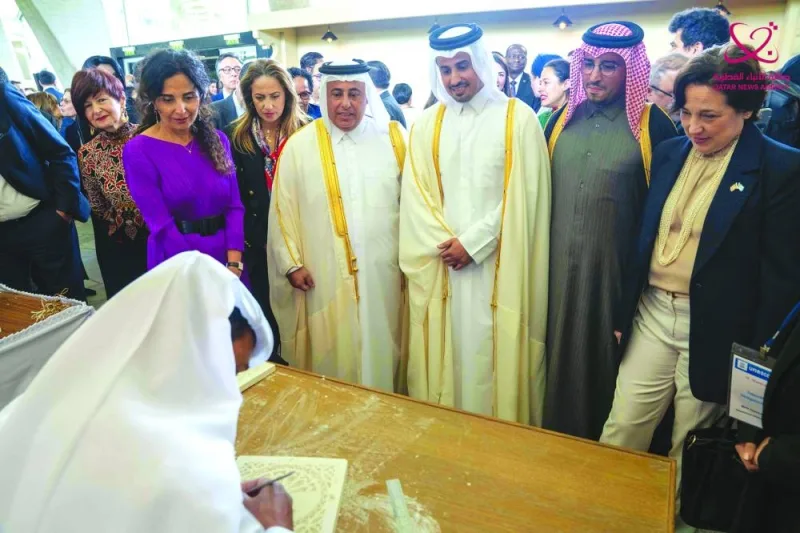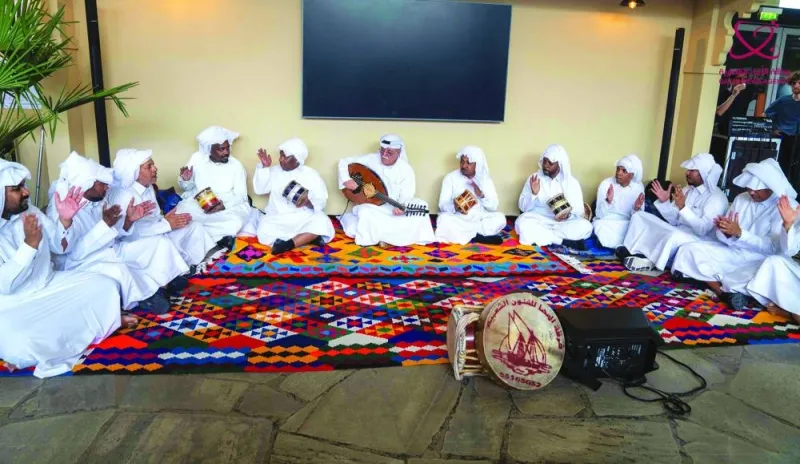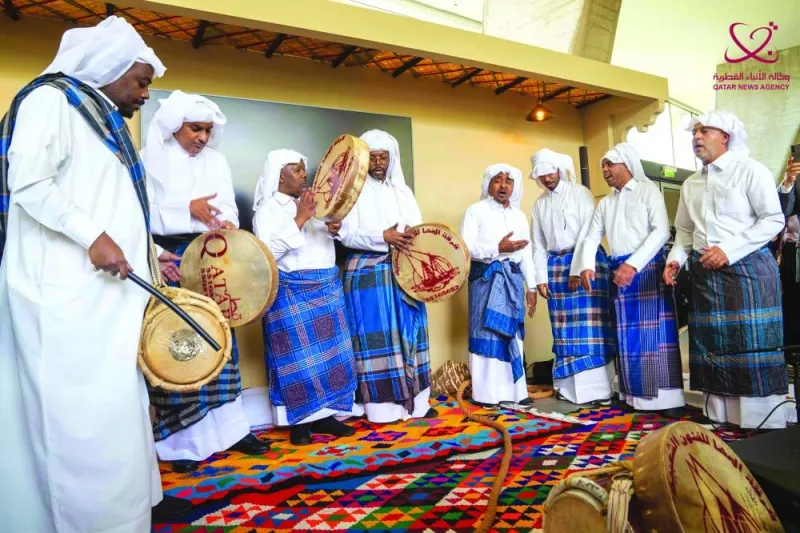The Ministry of Culture organised on Monday a special celebration at the Unesco headquarters in France commemorating the 20th anniversary of the 2003 Convention for the Safeguarding of the Intangible Cultural Heritage.
The event was attended by President of the 42nd session of the General Conference, Simona Mirela Miculescu, Chairperson of the Unesco Executive Board, Vera El Khoury, and Director of World Heritage at Unesco Lazare Eloundou Assomo, along with several ambassadors and officials.
The event aimed to highlight Qatar's efforts in protecting and preserving intangible cultural heritage, as recognised by the convention's imperative to safeguard living heritage and enhance dialogue among peoples, cultural diversity, and human creativity.
In his speech at the ceremony, Assistant Undersecretary for Cultural Affairs at the Ministry of Culture, Dr Ghanim bin Mubarak al- Ali expressed delight to inaugurate the heritage and cultural exhibition to celebrate Qatar's heritage at Unesco headquarters in Paris.
Al-Ali elaborated that the exhibition, organised by the Ministry of Culture in conjunction with the 20th anniversary celebration of the 2003 Convention for the Safeguarding of the Intangible Cultural Heritage, promotes dialogue among peoples, cultural diversity, and human creativity. It aims to increase awareness of the importance of intangible cultural heritage, which includes significant aspects of Qatar's heritage, such as crafts, industries, customs, and traditions.
He emphasised Qatar's commitment to safeguarding its intangible cultural heritage by promptly registering files on Unesco's Representative List of the Intangible Cultural Heritage of Humanity, including "Al Majlis" and "Arab Coffee".
He added that the Ministry of Culture has been collaborating with a group of countries for months to prepare a file for the registration of "Al Bisht" on the list as well. "Al Bisht", along with "Al Sqarah" (falconry), "Al Majlis", and "Arab Coffee", represents rich elements of "our culture that reflect an inherited legacy passed down through generations to remain resilient against the threat of disappearance, serving as a conduit for the continuous creativity and engagement with our environment and history. The value of these registered heritage elements, along with others presented in this exhibition, does not stop at their benefit to our identity. Instead, they enhance the presence of our heritage within the framework of human heritage components, contributing culturally to enriching cultural diversity worldwide."
Al Ali said that intangible cultural heritage occupies a significant place in Unesco s work, as evidenced by the legislative framework established by the 2003 Convention for its protection. He pointed out that Qatar believes that this heritage, passed down through generations and constituting a diverse cultural legacy for humanity, contributes to building a community's self-identity, thereby enhancing dialogue with other societies.
He explained that cultural heritage and dialogue are interrelated, and protecting cultural heritage ensures the sustainability of dialogue and enables people to reach the horizon of sustainable development. He called for collective efforts to strengthen the belief of generations in our cultural heritage, hoping that the exhibition would be a means of cultural rapprochement.
In a speech at Unesco headquarters, Ambassador of Qatar to the French Republic, Sheikh Ali bin Jassim al-Thani, expressed his pleasure to attend the cultural exhibition organized by the Ministry of Culture of the State of Qatar to celebrate the 20th anniversary of the Convention for the Safeguarding of Intangible Cultural Heritage.
He added that Qatar's deep interest and steadfast commitment to the principles enshrined in the convention are not merely symbolic, but an integral part of Qatar's vision and national aspirations.
The ambassador emphasised the wise government's keenness to preserve the national identity of Qatar, and to achieve this goal, Qatar National Vision 2030 is considered a shining beacon towards sustainable development and the preservation and promotion of culture globally.
He noted that from traditional customs to culinary traditions and handicrafts, Qatar's intangible cultural heritage is a source of pride, perseverance, and community unity. In this regard, it will be essential to recognize other aspects of Qatar's rich intangible heritage and protect them. To this end, Qatar has recently proposed additional features of its heritage to be safeguarded, including henna, an ancient tradition cherished for its aesthetic and social importance, in addition to prioritizing the preservation of the heritage, skills, and ancient practices associated with the traditional attire known as ''Al Bisht'' and the Qatari traditional dance, known as 'Al Ardah,' as a candidate for inclusion in the list. He added that Qatar has proposed adding the traditional Qatari women's attire known as ''Al Nashl'' to the nomination list, along with Arabic calligraphy, a shared heritage among Arab countries.
He looked forward to Unesco's support in adding these elements to Qatar's intangible heritage list, ensuring a comprehensive approach to safeguarding Qatar's cultural heritage for future generations. He stressed that Qatar's commitment to the convention reflects its commitment to international co-operation and solidarity in preserving cultural heritage through active participation in Unesco's efforts to protect intangible cultural heritage and contributing to a global dialogue that transcends borders and promotes understanding, tolerance, and mutual respect among nations.
HE Permanent Representative of Qatar to Unesco Dr Nasser bin Hamad al-Hanzab expressed pride in celebrating Qatar's rich culture and heritage at the Unesco headquarters, which reflects Qatar's commitment to promoting the goals and values of the 2003 Convention for the Safeguarding of the Intangible Cultural Heritage, which Qatar ratified in 2008.
He added that since joining Unesco, Qatar has worked diligently, guided by its deep belief in noble goals, to enhance international peace and security through its areas of expertise, achieve sustainable development goals, promote concepts of coexistence among different cultures, and empower local communities through culture, adding that in today's era of rapid communication, there are modern challenges that profoundly impact the present and future.
He emphasized that Qatar, through the implementation of economic, social, and cultural development plans at the national level under the wise leadership of His Highness the Amir Sheikh Tamim bin Hamad al-Thani, aims to achieve the goals of its Qatar National Vision 2030, adding that preserving its cultural heritage is a fundamental pillar for enhancing its culture as one of the essential elements of development at the national and international levels, and reinforcing its values that embody its Qatari, Arab, and Islamic identity while remaining open to others.
He pointed out that at the international level, Qatar, through the Ministry of Culture, works to enhance dialogue between different cultures, through Unesco and other international multilateral institutions, to strengthen communication bridges among the world's peoples and promote understanding and peace through various cultural domains.
Dr al-Hanzab continued that to enhance intangible heritage, Qatar has begun completing several national and joint files for registration on the list of intangible heritage, to introduce the world to its ancient heritage and the role of the Qatari society in revitalising it for future generations.
An exhibition highlighting Qatari cultural heritage was held on this occasion. The exhibition featured the "Majlis," in addition to a showcase of crafts and traditional industries that shed light on these crafts and industries and recognised their practitioners. The exhibition also included falconry, which was registered on the list in 2015, as well as folk arts that presented maritime arts displays, including "Al Fajri Art," to showcase the richness and diversity of Qatari culture. Additionally, a section of Qatari traditional culinary arts was presented, showcasing distinctive dishes from Qatari cuisine. The exhibition also included a pavilion displaying photographs highlighting Qatar's achievements in safeguarding intangible heritage.

Guests and officials watch a Qatari artist at work during the special celebration organised by Qatar's Ministry of Culture at the Unesco headquarters in Paris.



